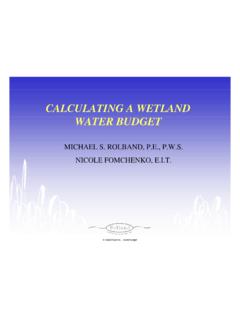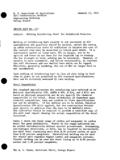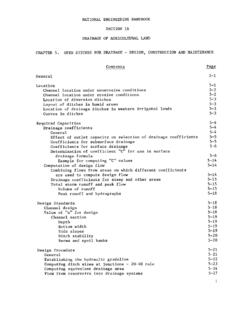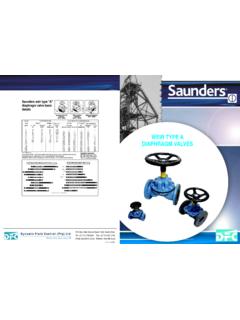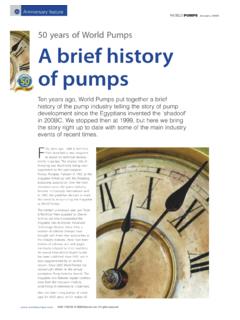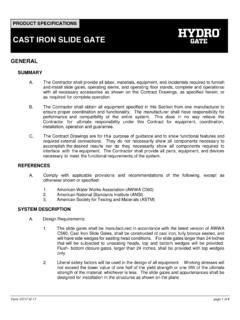Transcription of Submerged Weir Flow - Irrigation ToolBox
1 U. S. Department of Agriculture Soil Conservation Service Engineering Division Design Branch DESIGN NOTE NO. 15% Subject: Submerged Weir Flow Weir flow over a drop spillway is either free flow or Submerged flow. Free (unsubmerged weir) flow exists when the tailwater surface is at or below the crest of the weir. Submerged weir flow exists when the tail- water surface is above the crest of the weir. The depth of submergence is the difference in elevation between the downstream water surface and the crest of the weir. For free flow conditions the discharge through the weir is independent of the tailwater elevation and the depth at the weir is usually taken as critical depth, For Submerged weir flow, the discharge may or may not be independent of the tailwater elevation. When the depth of sub- mergence is of the critical depth or less, the discharge is usually taken as equal to the free discharge.
2 For greater submergence, the dis- charge is determined by both the headwater and tailwater depths (see / Fig. 1). Energy Grade Line rn Fig. 1 H = Specific energy head at crest of weir, ft 1 H2 = Submergence over the crest = difference in elevation between tailwater and crest of weir, ft *Prepared by H. J. Goon of the Design Unit, Design Branch, Hyattsville, Maryland. L = Length of weir, ft C = Discharge coefficient for free flow Qf - Discharge for free flow = C L H~~~~, cfs Q f qf =- Discharge for free flow per foot length of weir = -, cfs/ft L Qs E Discharge for Submerged flow, cfs Qs q E Discharge for Submerged flow per foot length of weir = - cfs/ft S L ' The discharge for Submerged flow is taken as Qs = R Qf qs = R qf where R is assumed to be a function of submergence ratio -. , H- Figure , page of NEH-11, Drop Spillways, gives the relation be- H2 tween R and - This figure was prepared by analyzing available test H, data of Submerged flow over several types of weirs and earth embankments.
3 The data indicate a wide band of values of R for given values of the submergence ratio. Therefore, precise results should not be expected from Figure If precise results are necessary, a search of liter- ature for discharge data from appropriate weirs or a model study is required. Figure is reproduced on Sheet 1 of ES-207. Observe that when % and H2 are given, H1 can not be explicitly evaluated from Sheet 1, ES-207. Although H, may be solved by cut-and-try methods, it is desirable to transform the graph of Sheet 1, ES-207 into a form such that H, can be explicitly evaluated. The transformed graph is given in Sheet 2 of ES-207. Thus 1. when H1 and q are given, Sheet 1 is used to determine Hz (see S Example 1, Sheet 3 of ES-207). 2. when q, and H, are given, H1 can be explicitly evaluated from Sheet 2, ES-207. (see Example 2). 3. when H, and H2 are given, either Sheet 1 or Sheet 2 ma$ be used to determine qs.
4 Relation Between Submergence and Discharge SP'LLWAYS: Given HI and qs, determine Hz "2 Values of 1 Energy Grade Line /-I7 I I rCrest Elevation H1 E Specific energy head at crest of weir, ft. H2- Submergence over the crest = Vertical distance between tailwater and crest of weir, ft. qs = Discharge for Submerged flow per foot length of weir, cfs/ft. qf z Discharge for free flow per foot length of weir, H~~ 1 .( H2 Values of ~1 REFERENCE NEH-11 Drop Spillways Page U. S. DEPARTMENT OF AGRICULTURE SOIL CONSERVATION SERVICE ENGINEERING DMSION - DESIGN UNIT STANDARD DWG. NO. ES - 207 SHEET2 OF 3 DATE 3 - 73 Relation Between Submergence and Discharge SP'LLWAYS: Given H2 and CIS, determine HI REFERENCE NEH-11 Drop Spillways Page U. S. DEPARTMENT OF AGRICULTURE SOIL CONSERVATION SERVICE ENGINEERING DIVISION - DESIGN UNIT STANDARD DWG. NO. ES- 207 SHEETL OF 3 DATE 3 - 73 Relation Between Submergence and Discharge DROP SPILLWAYS: Given: A drop spillway with Submerged flow _CC Discharge coefficient, C = Specific energy head, H1 = ft Length of weir, L = 19 ft Discharge, Qs = 480 cf s Determine: Submergence over the crest, H2 Solution: Qf = L H,~/~ = (19)( )~/~ =507 cfs Ekample 2 Given: A drop spillway with Submerged flow Length of weir, L = 19 ft Discharge, Q, = 480 cfs Submergence over the crest, H2 = ft Determine: Specific energy head, H1 --== Solution: qs - Qs 480 cfs/ft 19 J.)
5 -- - (sheet 2, ES-207) H2 REFERENCE NEH-11 Drop Spillways Page U. S. DEPARTMENT OF AGRICLTLTLTRE SOIL CONSERVATION SERVICE ENGINEERING DIVISION - DESIGN UNIT STANDARD DWG. NO. ES- 207 SHEET3 OF 3 DATE 3 - 73
